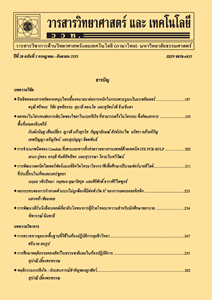ปัจจัยที่มีผลต่อพฤติกรรมการคัดแยกขยะมูลฝอยครัวเรือนของผู้อยู่อาศัยในตำบลหนองกะท้าว อำเภอนครไทย จังหวัดพิษณุโลก
Main Article Content
Abstract
This cross-sectional study aimed to explore the knowledge, attitudes and behaviors of household waste separation among residents, to study the factors affecting household waste disposal behavior of the residents, and to study the ability of prediction of household waste disposal behavior among the residents in Nong Ka Tha subdistrict, Nakhon Thai district, Phitsanulok province. The researcher gathered all data from the studied population of 180 households via a survey, and then analyzed the information through descriptive statistics, i.e. Eta, Pearson correlation and stepwise multiple regression analyses. The results of showed a high level of knowledge of waste segregation at 67.20% of households. The attitude towards waste segregation was 60 %, while waste segregation behavior was 88.30 %. Factors affecting waste segregation behaviors, i.e. receiving waste segregation suggestions from household members and their neighbors (beta = 0.337), attitudes of household waste segregation (beta = 0.369), the number using recycling services (0.232), and obtaining information about household waste segregation (0.148), together predicted the behavioral household waste segregation at 41.60 %, with statistically significant level of 0.05. The outcomes from this study may be beneficial in applying to waste management and finding solutions for household waste segregation and a positive impact on households.
Article Details
References
[2] Yves, C. and Jorge E., 2014, Safe Management of Wastes from Health-care Activities of World Health Organization, 2nd Ed., Biotext, Malta, 329 p.
[3] Wongcharoen, S., 2551, Garbage Separation Guide: Prajai House, Wong Phanit, Bangkok, 152 p. (In Thai)
[4] Office of Environment Region 3, Phitsanulok Province, Annual Report 2016: Solid Waste Volume Data of Phitsanulok Province, Available Source: https://www.reo3.go.th, August 30, 2017. (in Thai)
[5] Nakhon Thai Municipality Public Health Division, 2016, Feasibility Study and Design for Municipal Solid Waste Management System, Solid Waste Management, Nakhon Thai Subdistrict Municipality, Phitsanulok, 152 p. (in Thai)
[6] Nong Kathao Subdistrict Administrative Organization, 2016, Three-Year Development Plan 2015-2017 Phitsanulok, Nong Kathao Subdistrict Administrative Organization, Phitsanulok, 142 p. (in Thai)
[7] Bunchan, S., 2016, Factors Affecting Garbage Separation Behavior of Housewives in Bueng Phra Subdistrict, Muang District, Phitsanulok Province, Master's Thesis, Naresuan University, Phitsanulok.
[8] Distirphalang, M., 2012, Factors Affecting the Waste Sorting Behavior of People in Tha Chin Municipality, Muang District, Samut Sakhon Province, Master's Thesis, Kasetsart University, Bangkok, 112 p. (in Thai)
[9] Kongphirun, W., Thayom, S. and Chantra, V., 2017, Factors affecting waste manage ment behavior in Ban Pong Pa, Kaeng Sopha Subdistrict, Wang Thong District, Phitsanulok Province, Thai J. Publ. Health 26: 310-321.
[10] Mathews, E. and Rani, S., 2010, Health hazards assessment among the solid waste workers of Thiruvananthapuram Corporation, Kerala Environment Congress (KEC 2010), Kerala.
[11] Department of Environmental Quality Promotion, 2014, Urban overcapacity, impact on the environment caused by ourselves, Thai J. Green Res. 11: 1-10. (in Thai)
[12] Phawasan, P., 2013, Removing lesson 5 community waste management, Thai J. Environ. 18: 48-54. (in Thai)
[13] Wayne, W.D., 1995, Biostatistics: A Foundation of Analysis in the Health Sciences; 6th Ed., John Wiley & Sons, New York.
[14] Basic Database, Population, 2016, Civil Registration Information, Nakhon Thai District, Nakhon Thai District Office, Phitsanulok. (in Thai)
[15] Chuenmuenwai, K., 2011, Participation of the population in solid waste separation at the Taepalai Municipality, Khong District, Nakhon Ratchasima Province, Thai J. Perspect. Publ. Health Khon Kaen Univ. 4: 18-22. (in Thai)
[16] Treewai, M., 2012, Factors Affecting the Success of Municipal Waste Separation Program: A Case Study of Khlongsan District, Bangkok, 14 p. (in Thai)
[17] Wiseschart, S., Sila, S. and Sangjun, S., 2017, Factors associated with solid waste separation behavior of people living in the 2nd community, Wang Nam Yen, Thai J. Commun. Develop. 5: 422-433. (in Thai)
[18] Nateewattana, J. and Tienthavorn, V., 2017, Knowledge and attitude to waste reduction behavior of Mae Ka community, Muang District, Phayao Province, Thai Sci. Technol. J. 25: 1-15. (in Thai)
[19] Kanchan, P., Juito, S. and Somsueb, C., 2015, Factors affecting the partpcppation of citizens in the management of solid waste of municipalities in Pathum Thani province, Research and Development, Thai J. Res Develop. 10: 295-302. (in Thai)


